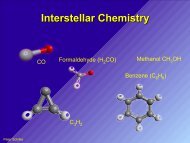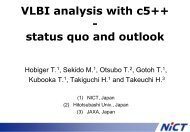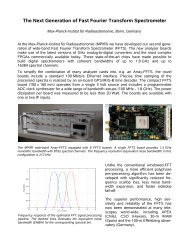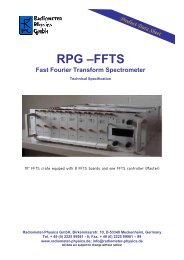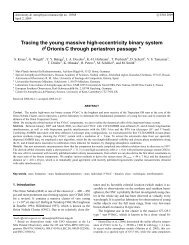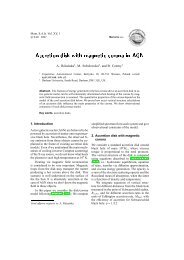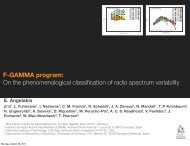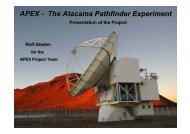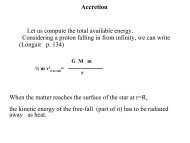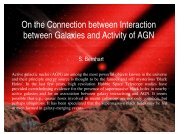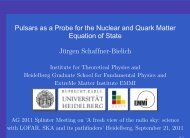B. Parise et al.: Models of <strong>HDO</strong> <strong>emission</strong>, Online Material p 3Table A.1. continued.Transition Freq. E up A ul Line flux(GHz) (cm −1 ) (s −1 ) (ergs −1 cm −2 )6 2,5 − 5 2,4 2735.28 384.812 4.22 × 10 −2 6.9 × 10 −152 2,0 − 1 0,1 2810.88 109.204 2.43 × 10 −4 2.2 × 10 −156 1,5 − 5 1,4 2916.11 362.440 5.53 × 10 −2 1.5 × 10 −143 2,1 − 2 1,2 2966.08 156.995 1.62 × 10 −1 5.8 × 10 −144 2,3 − 3 1,2 3015.33 216.972 2.05 × 10 −1 4.6 × 10 −145 3,3 − 5 1,4 3250.64 373.591 7.43 × 10 −4 9.9 × 10 −175 2,4 − 4 1,3 3317.29 293.559 2.63 × 10 −1 3.6 × 10 −143 2,1 − 2 0,2 3324.45 156.988 8.77 × 10 −4 4.6 × 10 −154 3,2 − 4 1,3 3372.77 295.409 4.06 × 10 −4 1.0 × 10 −163 3,1 − 3 1,2 3494.45 232.943 1.57 × 10 −4 6.6 × 10 −176 2,5 − 5 1,4 3586.70 384.793 3.37 × 10 −1 2.4 × 10 −144 2,2 − 3 1,3 3640.83 221.751 1.96 × 10 −1 5.9 × 10 −143 3,1 − 2 2,0 3710.07 232.938 6.26 × 10 −1 3.6 × 10 −143 3,0 − 2 2,1 3721.17 232.965 6.30 × 10 −1 3.5 × 10 −144 2,2 − 3 0,3 3912.47 221.746 1.99 × 10 −3 4.4 × 10 −153 3,0 − 3 1,3 3977.05 232.958 1.37 × 10 −4 5.8 × 10 −174 3,2 − 3 2,1 4149.80 295.391 6.85 × 10 −1 3.4 × 10 −144 3,1 − 4 1,4 4175.96 295.581 3.25 × 10 −4 8.7 × 10 −174 3,1 − 3 2,2 4205.74 295.580 7.02 × 10 −1 3.3 × 10 −143 3,0 − 3 0,3 4248.69 232.953 2.23 × 10 −3 8.7 × 10 −164 3,1 − 4 0,4 4362.61 295.576 8.17 × 10 −3 2.0 × 10 −155 2,3 − 4 1,4 4425.31 303.892 2.21 × 10 −1 4.9 × 10 −145 3,2 − 5 1,5 4453.27 374.306 5.25 × 10 −4 8.5 × 10 −175 3,3 − 4 2,2 4551.74 373.561 7.54 × 10 −1 3.0 × 10 −145 3,2 − 5 0,5 4570.75 374.304 1.73 × 10 −2 2.5 × 10 −155 2,3 − 4 0,4 4611.96 303.888 3.35 × 10 −3 2.6 × 10 −155 3,2 − 4 2,3 4717.77 374.300 7.96 × 10 −1 2.9 × 10 −143 3,0 − 2 1,1 5002.54 232.935 4.68 × 10 −4 1.8 × 10 −163 3,1 − 2 1,2 5243.27 232.902 4.16 × 10 −4 1.5 × 10 −164 3,1 − 3 1,2 5372.76 295.553 1.32 × 10 −3 3.3 × 10 −163 3,1 − 2 0,2 5601.64 232.894 3.24 × 10 −3 7.3 × 10 −165 3,2 − 4 1,3 5738.82 374.277 2.85 × 10 −3 4.7 × 10 −164 3,2 − 3 1,3 5848.84 295.351 1.02 × 10 −3 1.8 × 10 −164 3,2 − 3 0,3 6120.47 295.346 1.56 × 10 −2 1.5 × 10 −155 3,3 − 4 1,4 6514.00 373.515 1.83 × 10 −3 1.8 × 10 −165 3,3 − 4 0,4 6700.65 373.511 4.38 × 10 −2 2.7 × 10 −15
Appendix B: The <strong>low</strong> luminosity case: L1448 mmWe present here the results for the case of the <strong>low</strong>-luminositysource L1448 mm. The density and temperature profiles wherederived by Jørgensen et al. (2002).B. Parise et al.: Models of <strong>HDO</strong> <strong>emission</strong>, Online Material p 4Fig. B.1. <strong>HDO</strong> line fluxes predicted for the case of the <strong>low</strong>-luminositysource L1448 mm, for an assumed <strong>HDO</strong> abundance of 10 −10 and 10 −7in the cold and warm parts of the envelope respectively. The upperpanel presents the transitions observable <strong>from</strong> the ground, the middlepanel the transitions observable with HSO/HIFI and the <strong>low</strong>er panelthe transitions observable with SOFIA. The frequencies of the transitionsthat are going to be studied in more detail are indicated in GHz.Fig. B.2. Line intensity as a function of the <strong>HDO</strong> abundance in theouter and inner regions of the envelope, x cold and x warm respectively,for the eight <strong>HDO</strong> transitions at 464, 893, 509, 80, 241, 225, 919 and995 GHz respectively towards the <strong>low</strong>-luminosity source L1448 mm.Line fluxes are in erg s −1 cm −2 . In these calculations the mantle evaporationtemperature is 100 K.



